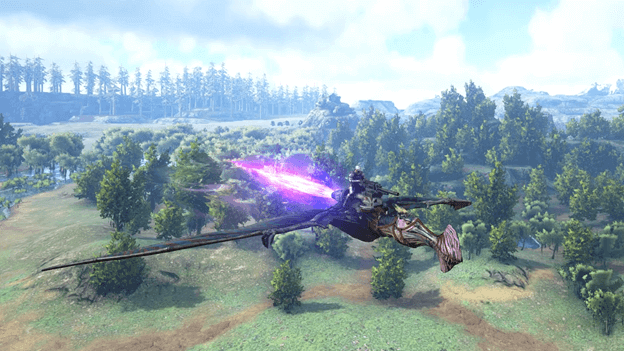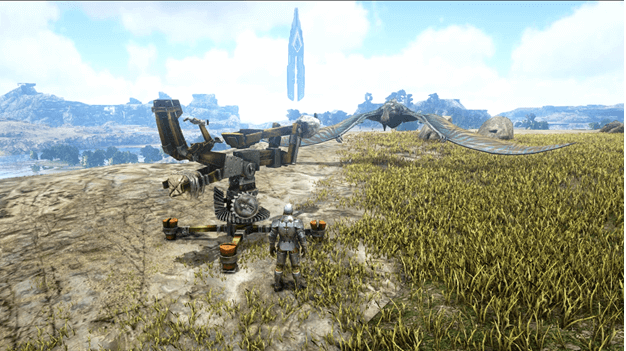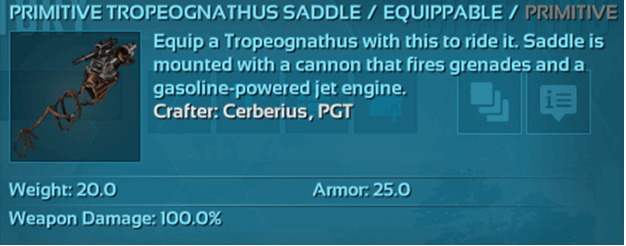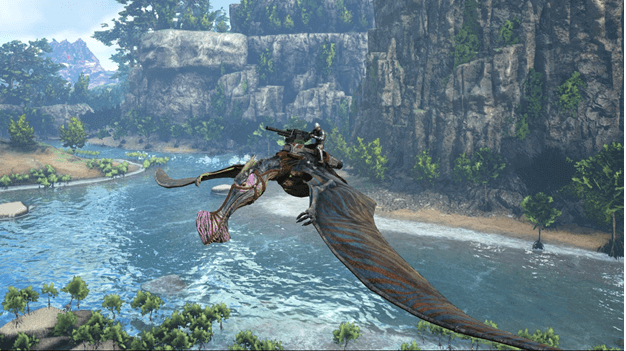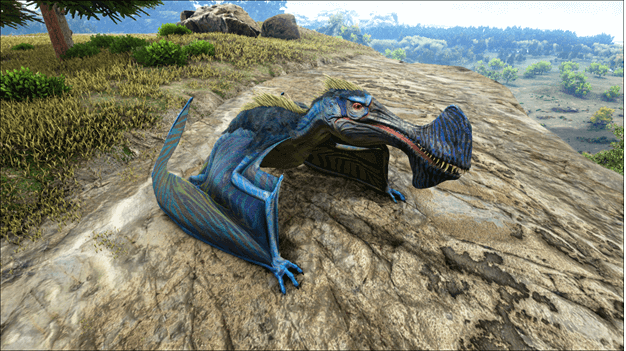
The Tropeognathus is one of the middle-sized flying creatures which was first seen when Crystal Isles was introduced.
It is a carnivorous flyer that has a large wingspan and is capable of better maneuvers than most flyers in Ark.
One of its best features is that it can be a scout and a combat flyer once players have tamed it and equipped it with a saddle.
Check Out Our Other Creature Guides
Abilities
1) Jet Mode
Activating this allows the Tropeognathus to go into Jet Mode, giving it a boost and causing it to fly forward, enabling the use of the Grenade Cannon.
Using your primary fire while the Tropeognathus is in Jet Mode will allow you to shoot Grenades from its cannon as long as it has Grenades in its inventory.
Jet Mode can be activated by pressing controls:
- Left Ctrl (PC)
- RB (Xbox)
- R1 (PS4)
2) Grind Items (Inventory)
The Tropeognathus has the option to grind items in its inventory, which can be done by opening it by interacting with the creature and pressing the grind option.
Uses
Scout
The Tropeognathus can be ridden even without a saddle and is even faster when equipped with one, making it a good early game flyer as well as a mid-game scout.
Combat Flyer
With its speed and combat ability, the Tropeognathus can be used to fight flyers, guard aerial transports, and deal damage from above.
Bomber
Players can safely bombard enemy bases, tamed creatures, and players from above, giving those with one an advantage over those on the ground.
Transport
Being able to carry a decent amount of weight, this creature can easily fly around while helping players bring items from one place to another.
Portable Grinder
With the ability to grind items, the Tropeognathus can be considered as a portable grinder and can break down items that are not needed into resources.
How to Tame Tropeognathus?
To tame a Tropeognathus, you will need to hit it with a Chain Bola, which can be done by placing them in a Ballista Turret and firing it at the creature.
A Tropeognathus will become tameable (passively tamed) once it has been downed with a Chain Bola, allowing you to feed it its preferred food.
Although these creatures are passive tames, they will still attack you once you attack them, allowing you to lure them to a Ballista Turret or into a trap.
An easy way to tame a Tropeognathus is to lure it into a trap made from Dinosaur Gateways so that you can set up a Ballista Turret.
Another way is to damage the Tropeognathus so that it uses up its food to quickly heal, that way you can continuously feed it once you down it with a Chain Bola.
Food
Kibble
- Exceptional Kibble
Other Food
- Raw Mutton
- Raw Prime Meat
- Cooked Lamb Chop
- Cooked Prime Meat
- Mejoberry
- Cooked Meat
Tropeognathus Saddle
A Tropeognathus can be ridden once it has been tamed, even without a saddle but to use its Grenade Cannon and Thrusters, you will have to equip it with one.
Tropeognathus Saddle crafting resources:
- 120 x Crystal
- 450 x Fiber
- 600 x Metal Ingot
- 250 x Polymer
Breeding
Egg
Tropeognathus can mate when a male and female are kept together and allowed to breed, resulting in the female dropping a Tropeognathus Egg which is purple with navy-colored spots.
It takes up to 1 hour and 40 minutes to hatch a Tropeognathus egg and requires a temperature of at least 29°C to 32°C or 84°F to 90°F.
Drops
Resources Harvested from Tropeognathus Body
- Hide
- Raw Meat
Location
Tropeognathus can be found flying around The White Shoals (bottom left), Emberfall (right side near bottom), or around The Great Valley (bottom right) in Crystal Isles.
- The White Shoals (65 – 23)
- Emberfall (53 – 60)
- The Great Valley (71 – 72)
These coordinates are pinned to the center of each location and players will need to explore and search for the Tropeognathus as they wander the area.
Overview
A Tropeognathus is a great mount for those who prefer aerial combat or those who love to bombard enemies and attack from the sky.
While taming a Tropeognathus may be a bit hard for some players, especially at the start, setting up a trap and making the right preparation can make it easy to tame them.
These creatures are great for offensive attacks and can change the tide of battle when it comes to attacking or defending a base.
